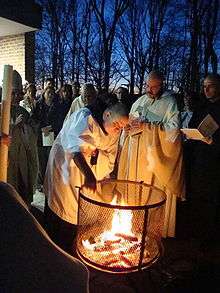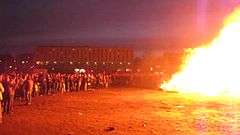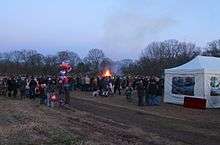Easter Fire



Easter fires are typically bonfires lit before, during, or after Easter Sunday as part of secular and religious celebrations.
Easter Vigil
Fire can feature prominently during solemn Easter Vigil celebrations held after sunset on Holy Saturday. Such a fire might be used to light a Paschal candle or other candles used symbolically before or during mass or other religious celebration.[1][2][3]
In Fredericksburg, Texas, each year the residents have Easter Fires the night before Easter, commemorating a peace treaty with the Comanche Indians. In 1847 when the original treaty was signed, the Comanches lit signal fires on the area hills. One mother calmed her children's fears, telling them the smoke came from the Easter Bunny who was dyeing eggs.[4] This tradition is more akin to the Northern European fires discussed below than the solemn Easter Vigil fires mentioned above.
Good Saturday, Easter Sunday and Easter Monday
On Good Saturday and Easter Sunday in rare occasions also on Easter Monday, large fires are lit at dusk in sections of Northwestern Europe. These regions include Denmark, parts of Sweden as well as Finland, Germany, Switzerland and Austria.
It is a Saxon, pre-Christian tradition, that is still performed each year. There are several explanations of the meaning of these fires. The Saxons probably believed that around the time of Easter, Spring becomes victorious over Winter. The fires were supposed to help chase the darkness and winter away. It was also a symbol of fertility, which works in a literal sense in that the ashes were scattered over the meadows and thereby fertilized the soil. The pre-Christian meaning of Easter fires is hardly experienced anymore. Nowadays they are meant to bring the community together, which guarantees a pleasant night combined with the consumption of gin or lager and snacks.

In northern Germany, Easter Fires (in German: Osterfeuer, ![]() listen ) are lit around sunset on Holy Saturday. Each of the federal states have their own regulations for allowing and/or the way of staging Easter Fires: While in the city and state of Hamburg, private persons are allowed to have an Easter Fire of any size on their own premises, in Schleswig-Holstein, for example, only the wide-spread voluntary fire brigades are allowed to organize and stage them on open fields. Over the past years, Easter Fires themselves have become larger and developed to smaller versions of Volksfests with some snack stands selling Bratwurst, steak in bread rolls, beer, wine, and soft drinks as well as maybe one or two rides for the children. Usually, Easter Fires are kept burning over hours until dawn (roughly around 6 o'clock) and cause therefore a special atmosphere during the whole Easter Night with their bright lights in the dark and the omnipresent smell of smoke.
listen ) are lit around sunset on Holy Saturday. Each of the federal states have their own regulations for allowing and/or the way of staging Easter Fires: While in the city and state of Hamburg, private persons are allowed to have an Easter Fire of any size on their own premises, in Schleswig-Holstein, for example, only the wide-spread voluntary fire brigades are allowed to organize and stage them on open fields. Over the past years, Easter Fires themselves have become larger and developed to smaller versions of Volksfests with some snack stands selling Bratwurst, steak in bread rolls, beer, wine, and soft drinks as well as maybe one or two rides for the children. Usually, Easter Fires are kept burning over hours until dawn (roughly around 6 o'clock) and cause therefore a special atmosphere during the whole Easter Night with their bright lights in the dark and the omnipresent smell of smoke.
Some municipalities in the Netherlands hold an annual competition to build the highest, or the neatest fire. The hamlet of Espelo in the municipality of Rijssen-Holten holds the world record with an Easter fire that measured 45.98 meters high. In the Netherlands, most of these fires take place in the provinces of Drenthe, Groningen, and Gelderland, with the largest being in Twente, a part of Overijssel.
See also
References
- ↑ "spirituality and worship". Liturgy. 2008-02-09. Retrieved 2013-12-30.
- ↑ "Trinity Episcopal Church". Photos.trinityjanesville.org. 2009-12-24. Retrieved 2013-12-30.
- ↑ "Old St. Mary's Church". Oldstmarys.org. 2006-01-29. Retrieved 2013-12-30.
- ↑ Texas State Historical Commission. "The Easter Fires". Historical Marker.
External links
| Wikimedia Commons has media related to Easter fires. |
- Paasvuursite (Easter Fire Site) (Dutch)